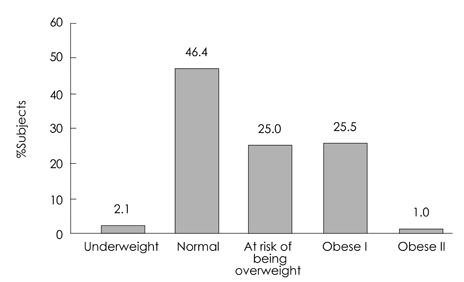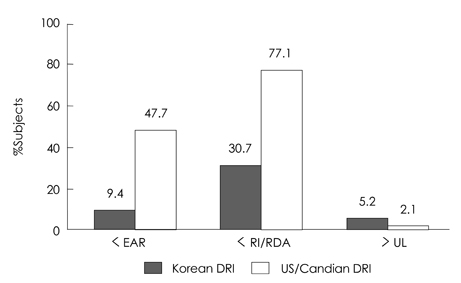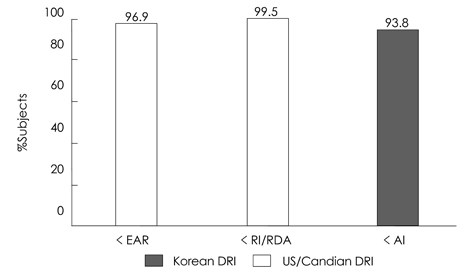Korean J Nutr.
2010 Dec;43(6):628-637. 10.4163/kjn.2010.43.6.628.
Intakes and Major Food Sources of Vitamins A and E of Korean Adults Living in Seoul and Gyeonggi Province
- Affiliations
-
- 1Department of Food and Nutrition, Duksung Women's University, Seoul 132-714, Korea. yunokcho@duksung.ac.kr
- KMID: 2268059
- DOI: http://doi.org/10.4163/kjn.2010.43.6.628
Abstract
- To determine vitamin A and E intakes and their food sources, dietary intakes were collected by three consecutive 24-hour recalls from 192 adults living in Seoul and Gyeonggi Province, Korea. The mean vitamin A, retinol and beta-carotene intakes were 1240.1 +/- 1101.1 microg retinol equivalent/day (693.3 +/- 563.2 microg retinol activity equivalent/day), 182.6 +/- 149.5 microg/day and 5443.3 +/- 6365.5 microg/day, respectively. Only 9.4% of the subjects consumed less than the Korean Estimated Average Requirement for vitamin A. The mean vitamin E intake was 6.03 +/- 2.54 mg alpha-tocopherol equivalent/day. The alpha-tocopherol and gamma-tocopherol intakes were 4.83 +/- 2.03 and 5.57 +/- 3.41 mg/day, respectively. Most of the subjects (93.8%) consumed less than the Korean Adequate Intake for vitamin E. The major food sources of vitamin A were sweet potato, carrot, red pepper powder, spinach, and citrus fruit, and the top 30 foods provided 91.5% of total Plant foods provided 81.0% and animalderived foods 10.5% of the vitamin A intake from the top 30 foods. The major food sources of vitamin E were soybean oil, red pepper powder, Ramyeon (cup noodles), spinach, and egg. The top 30 foods provided 78.0% of total vitamin E intake. Plant foods provided 61.3% and animal-derived foods 15.9% of the vitamin E intake from the top 30 foods. In conclusion, the vitamin A intake of the Korean adults in this study was ge-nerally adequate, but the vitamin E intake of many subjects was inadequate. Therefore, nutritional education may be of benefit to Korean adults to increase their vitamin E intake.
MeSH Terms
Figure
Cited by 3 articles
-
Vitamin A status of 20- to 59-year-old adults living in Seoul and the metropolitan area, Korea
Sungah Kim, Young-Nam Kim, Youn-Ok Cho
Nutr Res Pract. 2012;6(1):45-50. doi: 10.4162/nrp.2012.6.1.45.Estimated dietary intake of vitamin A in Korean adults: Based on the Korea National Health and Nutrition Examination Survey 2007~2012
Seong-Ah Kim, Shinyoung Jun, Hyojee Joung
J Nutr Health. 2016;49(4):258-268. doi: 10.4163/jnh.2016.49.4.258.Current status and trends in estimated intakes and major food groups of vitamin E among Korean adults: Using the 1~6th Korea National Health and Nutrition Examination Survey
Seoeun Ahn, Shinyoung Jun, Seong-Ah Kim, Kyungho Ha, Hyojee Joung
J Nutr Health. 2017;50(5):483-493. doi: 10.4163/jnh.2017.50.5.483.
Reference
-
1. Voko Z, Hollander M, Hofman A, Koudstaal PJ, Breteler MM. Dietary antioxidants and the risk of ischemic stroke: the Rotterdam Study. Neurology. 2003. 61(9):1273–1275.
Article2. Giugliano D. Dietary antioxidants for cardiovascular prevention. Nutr Metab Cardiovasc Dis. 2000. 10(1):38–44.3. The Korean Nutrition Society. Dietary Reference Intakes for Koreans. 2005. Seoul:4. Kim YN, Giraud DW, Cho YO, Driskell JA. Vitamin A inadequacy observed in a group of 2-to 6-year-old children living in Kwangju, Republic of Korea. Int J Vitam Nutr Res. 2007. 77(5):311–319.
Article5. Giraud DW, Kim YN, Cho YO, Dirskell JA. Vitamin E inadequacy observed in a group of 2-to 6-year-old children living in Kwangju, Republic of Korea. Int J Vitam Nutr Res. 2008. 78(3):148–155.
Article6. Kang HR, Jung HJ, Paik HY. Analysis of foods and nutrients intake obtained at the final probing step in 24-hour recall method. Korean J Nutr. 2009. 42:158–170.
Article7. Yun SH, Choi BY, Kim MK. The effect of seasoning on the distribution of nutrient intakes by a food-frequency questionnaire in a rural area. Korean J Nutr. 2009. 42:246–255.
Article8. Institute of Medicine, Food and Nutrition Board. Dietary Reference Intakes for Vitamin A, Vitamin K, Arsenic, Boron, Chromium, Copper, Iodine, Iron, Manganese, Molybdenum, Nickel, Silicon, Vanadium, and Zinc. 2000. Washington DC: National Academy Press.9. Institute of Medicine, Food and Nutrition Board. Dietary Reference Intakes for Vitamin C, Vitamin E, Selenium, and Carotenoids. 2000. Washington DC: National Academy Press.10. National Rural Living Science Institute, R.D.A. Food Composition Table. 2001. Seoul: Sangroksa.11. WHO Western Pacific Region. The Asia-Pacific Perspective: Redefining Obesity and Its Treatment. 2000. Geneva:12. Research Institute of Food and Nutritional Sciences, Yonsei University. Phytonutrient Contents in Vegetable/Fruits/Legumes. 2009. Seoul: Shinkwang.13. Kim YN, Giraud DW, Driskell JA. Tocopherol and carotenoid contents of selected Korean fruits and vegetables. J Food Compost Anal. 2007. 20(6):458–465.
Article14. Kim YN, Giraud DW, Driskell JA. Tocopherol and carotenoid contents of selected Korean cooked combination foods consumed by young Korean children. Nutr Sci. 2006. 9:323–329.15. USDA National Nutrient Database for Standard Reference, Release 21. accessed June-December, 2009. Available from: http://www.nal.usda.gov/fnic/foodcomp/search/.16. Ministry of Health and Welfare. Korea Centers for Disease Control and Prevention. The Fourth Korea National Health and Nutrition Examination Survey (KNHANES IV-2). 2008.17. Sato S, Demura S. Regional subcutaneous fat characteristics stratified by sex, age, and obesity, and their relationships with total and visceral fat in a Japanese population. J Physiol Anthropol. 2009. 28(5):231–238.
Article18. Ntanios FY, Homma Y, Ushiro S. A spread enriched with plant sterol-esters lowers blood cholesterol and lipoproteins without affecting vitamins A and E in normal and hypercholesterolemic Japanese men and women. J Nutr. 2002. 132(12):3650–3655.
Article19. Paterson E, Gordon MH, Niwat C, George TW, Parr L, Waroonphan S, Lovegrove JA. Supplementation with fruit and vegetable soups and beverages increases plasma carotenoid concentrations but does not alter markers of oxidative stress or cardiovascular risk factors. J Nutr. 2006. 136(11):2849–2855.
Article20. Moshfegh A, Goldman J, Cleveland L. What we eat in America, NHANES 2001-2002: usual nutrient intakes from food compared to dietary reference intakes. 2005. Maryland: U.S. Department of Agriculture, Agricultural Research Service Beltsville.21. Oh HM, Yoon JY, Cho SH, Yoon JS. Vitamin A and vitamin E status of diabetic patients and normal adults in Korea. Korean J Nutr. 2009. 42:318–326.
Article22. Ministry of Health and Welfare. Korea Health Industry Development Institute. In depth analysis on 1998 National Health and Nutrition Survey. 2000.23. Shim YJ, Paik HY. Reanalysis of 2007 Korean National Health and Nutrition Examination Survey (2007 KNHANES) Results by CAN-Pro 3.0 Nutrients Database. Korean J Nutr. 2009. 42:577–595.
Article24. Gao X, Wilde PE, Lichtenstein AH, Bermudez OI, Tucker KL. The maximal amount of dietary α-tocopherol intake in U.S. adults (NHANES 2001-2002). J Nutr. 2006. 136(4):1021–1026.
Article
- Full Text Links
- Actions
-
Cited
- CITED
-
- Close
- Share
- Similar articles
-
- Exposure Assessment of Vitamins and Minerals from Various Sources of Koreans
- Vitamin A and Vitamin E Status of Diabetic Patients and Normal Adults in Korea
- Estimated dietary intake of vitamin A in Korean adults: Based on the Korea National Health and Nutrition Examination Survey 2007~2012
- The food and nutrient intakes from daily processed food in Korean adults: based on the 6(th) Korea National Health and Nutrition Examination Survey data (2013 ~ 2015)
- Macronutrient, Mineral and Vitamin Intakes in Elderly People in Rural Area of North Kyungpook Province in South Korea




